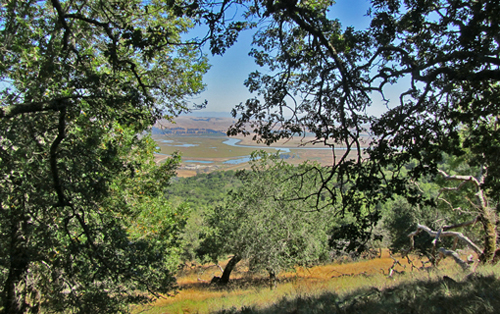Short-term funding solutions for state parks emerging, one by one

View from Mt. Burdell, Olompali State Historic Park (slated for closure)
On October 4, 2011, Governor Jerry Brown signed Assembly Bill 42 (authored by Assemblyman Jared Huffman, D-San Rafael) to allow nonprofits to help run up to 20 state parks.
Now that AB 42 presents a new tool for saving state parks on the closure list, on Wednesday I spoke with Roy Stearns, spokesperson for California State Parks, to find out if nonprofits have come forward with proposals. He said that groups have stepped up for three North Bay parks.
The Valley of the Moon Natural History Association is proposing to run the Jack London State Historic Park near Glen Ellen in Sonoma County. This all-volunteer nonprofit recently held a successful fundraiser and has more ideas for revenue generation.
In Napa, a county agency and a nonprofit are partnering up to save Bothe-Napa Valley State Park and Bale Grist Mill State Historic Park. The Napa County Regional Park and Open Space District and the Napa Valley State Parks Association are proposing a plan to make these parks operationally self-supporting. They will need donations of money and in-kind services to get things started and to take care of the most serious deferred maintenance issues.
The parks department expects to see many other proposals in the coming weeks. District park supervisors have been in talks with nonprofit state park cooperating associations since January. Around the state, 85 cooperating associations are members of the California League of Park Associations. Many of these groups have been nonprofit partners to state parks for decades, offering volunteers and education services.
Funding for state parks will become more localized
Before the parks crisis of today, the state parks department turned to regional public agencies and businesses to help run parks because, in some cases, nonprofits and private local companies can do a “better job than the state can,” said Stearns. In all cases, state rules apply, and the parks department provides some oversight. An earlier California law authorized the parks department to enter into operating agreements with government agencies.
The state currently holds contracts with 32 public agencies to run parks. The East Bay Regional Parks District runs Eastshore State Park, Lake Del Valle State Recreation Area and Emeryville Crescent State Marine Reserve. According to Stearns, 12 public agencies (city and county governments) have entered talks to operate parks on the closure list.
The parks department also holds 200 contracts with local private companies to run concessions like kayak rentals, snack bars, camping stores and cabins rentals.
Two nonprofits already have operating agreements for parks based on specific pieces of legislation. The Santa Barbara Trust for Historic Preservation runs the El Presidio de Santa Bárbara State Historic Park in Southern California. Near Tomales Bay north of San Francisco, California State Parks runs the Marconi Conference Center State Historic Park as a nonprofit unit.
One by one, a few parks saved
One by one, short-term solutions are emerging for at least some of the state parks on the closure list. The National Park Service rescued three Northern California parks. Philanthropists who love Henry Coe State Park will save that South Bay park in a unique agreement. While not final yet, a few nonprofits and public agencies are in various stages of developing proposals to run parks in their communities.
Blog series
This is the eighth article in a series on threats to California State Parks and the search for sustainable funding.

